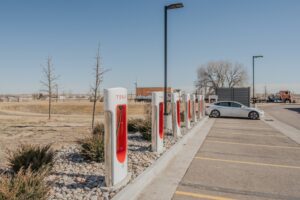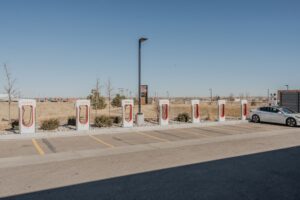Galloway’s EV Market Versatility
Projects in the electric vehicle (EV) market sector are driven by two motivators: legislation/ordinances or a vision. Galloway first became involved in the EV market about five years ago through a client with a vision to build a network of supercharging stations in the Mountain West region of the United States. Since then, Galloway has designed more than 1000 EV charging stations across 17 states.
five years ago through a client with a vision to build a network of supercharging stations in the Mountain West region of the United States. Since then, Galloway has designed more than 1000 EV charging stations across 17 states.
Galloway’s work in the EV market has since expanded into projects required by legislation, such as the nationwide Infrastructure Bill and the Colorado state-wide Senate Bill 260 and Climate Action Plan. Initiatives like these are becoming more common at the local government level nationwide.
Over the last several years, Galloway has developed collective experience through various clients and projects, which provides an advantageous Full Spectrum Approach to EV projects.
“We take our well-rounded experience, figure out the best approach to complete the project, then apply that knowledge to the project,” said Chris Carlson, regional architectural team manager and principal at Galloway.
As EV charging stations become increasingly prevalent, Galloway’s extensive experience in various project types provides a foundation of knowledge that effectively addresses different integration challenges for charging stations.
Commercial
Carlson leads one of Galloway’s most significant commercial EV projects. The program involves implementing electric delivery vehicles owned and driven by the client and charged on-site for more than 400 locations in 42 states.
As many large companies, such as the United States Postal Service, are converting to an electrical fleet, Carlson states there is a lot of opportunity in this market, and Galloway is ready for it.
“With the experience and knowledge we have acquired over the last few years, we can really educate commercial owners on what they need to think about. There are a lot of questions that people might not know to ask. I firmly believe in having these conversations upfront and educating the owner before we design,” said Carlson.
A typical list of questions Carlson and his team ask when designing for commercial EV projects are:
- Who asks for the EV – an end user, developer, or contractor?
- Why do you want EV chargers?
- Will they be for public or private use?
- What time of day and how frequently will the chargers be used?
- Have you coordinated with the utility company?
- What are the jurisdictional requirements?
- What do you need? How many chargers, and what type of chargers? Do you need protection around them?
- Is there a preferred location for them?
Gas stations/convenience stores
 EV platforms partnering with travel centers and gas stations is a relatively new trend in the industry. Understanding how EV affects trip generation and the overall design of a gas station or travel center is critical.
EV platforms partnering with travel centers and gas stations is a relatively new trend in the industry. Understanding how EV affects trip generation and the overall design of a gas station or travel center is critical.
“A traditional pump experience might take 10 minutes and turn over six people in an hour. With EVs, the experience could be 30 minutes to an hour, and people need something to do for an hour,” said Brian Horan, transportation team manager and senior associate at Galloway.
Trip generation decreases, and turnover is essential for the economy of a gas station; therefore, the character of the development needs to be accommodated accordingly. If the parking spot is now being used for an hour, there must be enough snacks, meals, entertainment, and electric charging to offset five other people who could have used that spot.
Multifamily
Local ordinances drive many multifamily EV projects. According to Justin Howell, electrical project manager and senior associate at Galloway, ordinance-driven projects are typically less flexible and require the ability to navigate the requirements within the ordinance properly, the jurisdictional requirements, the utility company’s capabilities, and the client’s vision.
Multifamily buildings require a substantial power supply, and depending on the size of the building, half or less of the power is used for EV charging. The power company needs to be aware that a significant amount of energy will be drawn from the grid during atypical hours due to the EV charging, and architects and engineers need to know how many amps per transformer the power company can supply.
Indicative of this is the Denver ordinance that requires 80% of multifamily parking stalls to be capable of being converted into EV charging stations, 15% to have the necessary wiring already available, and 5% to be working charging stations. Therefore, the number of units dictates the number of EV parking stalls and how much additional power is needed for those stalls.
Excel Energy, the power company in Denver, provides 4,000 amps per transformer. If you are going to go over the local power company transformer limit, Galloway provides a cost-benefit analysis of the different solutions.
“There are numerous nuances and trade-offs with EV charging, whether that is submetering (if the local jurisdiction allows it), getting a second transformer, or having different-level chargers,” said Howell. There are many ways to create an ideal design within the city and utility company requirements, and we always involve the client in the discussion of these options when making a decision.”
Municipal Considerations
Fortunately, many municipalities welcome EV initiatives, and there is no significant difference in their permitting and entitlement processes. However, sometimes a city will pass an ordinance, but it has not been coordinated with the local power supplier if they can provide the additional power to accommodate the ordinance.
Galloway’s team is familiar with this situation and, for multiple projects, has coordinated upfront with the client, jurisdiction, and local power company to discuss plans and feasibility and receive feedback on what needs to be approved on the planning and zoning level. Part of this discussion involves ensuring that the EV charging implemented is practical for the environment and everyone involved.
“We want to make sure these initiatives are not just checking a box but are practical as well,” said Nate Abbott, senior development services project manager and principal at Galloway. “Sometimes this involves negotiating requirements or amending code.”
For example, the city ordinance might state that certain buildings must have 20 level two chargers, but it would be more pertinent to people’s needs in the area to have 10 level three (the fastest chargers) chargers. Similar to the ratios for landscaping codes where one tree equals three shrubs, there can be a ratio in the code that states one level three charger equals two level two chargers.
Often, clients do not know that the city they want to develop in requires EVs and what that entails. Even a small dental office could require one EV charging stall. Regardless of whether a client is familiar with the jurisdictional requirements or not, Galloway’s team educates the involved parties, is familiar with local ordinances and how they impact development, and can adapt to each jurisdiction’s requirements.
“With our experience and Full Spectrum Approach, we can adjust and adapt our services accordingly,” said Abbott.
Work With Us
We are nationally recognized and locally preferred. We would love to work with you on your next project.
Contact Us